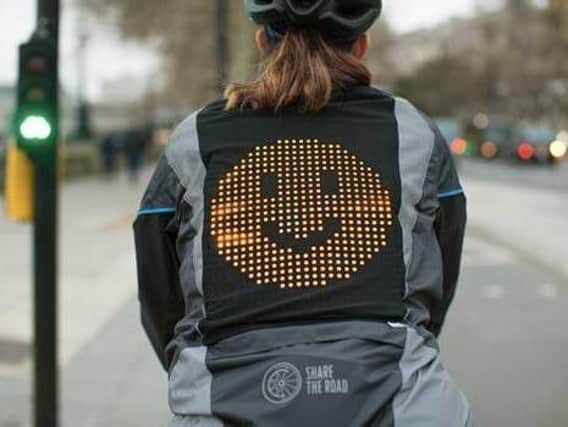Emoji jacket helps cyclists and drivers to communicate


Now car maker Ford has created an “Emoji Jacket” which allows cyclists to tell drivers how they are feeling through a series of emoticons displayed on an LED screen on the back of the coat.
The back of the jacket, which can be operated by a wireless remote attached to the handlebars features a large panel that allows the user to “effectively communicate their emotions” to other road users.
Advertisement
Hide AdAdvertisement
Hide AdThe panel displays the rider’s mood – whether they are happy, neutral, or worried – while travelling, as well as allowing them to display symbols such as indicators, and a hazard symbol to make other road users aware of the cyclist’s movements and possible dangers ahead.
These functions can be controlled without the cyclist removing their hands from the handlebars, thanks to a wireless remote featuring independent buttons that is mounted on the bike.
However, cycling groups questioned whether the jacket - which is not on general sale - would be likely to take off.
Jim Densham, Cycling UK policy manager for Scotland said: “Cycling is an everyday activity that doesn’t require special gear – marketing gimmicks like this aren’t needed and only benefit the company behind them.
“If Ford was truly concerned about cycle safety it would put effort into campaigning for safer streets and not cheap stunts.”
The prototype jacket was created in partnership with industrial design specialists Designworks as part of Ford’s ongoing ‘Share the Road’ campaign, which aims to “foster harmony between road users”.
The company, which worked with both cyclists and drivers to create the jacket, said that conflicts arise “as our ability to communicate is locked behind windscreens and inside helmets”.It said: “This one-of-a-kind creation, which is not available to buy, is designed to show how tensions could be eased by enabling riders to more easily and more clearly show drivers what their intentions are – and how they are feeling.”
Emoji expert Dr Neil Cohn said: “Emojis have become a fundamental part of how we use language. Whether used to convey facial expressions, humour, or sarcasm, they have become integral to our ability to express ourselves and quickly.
Advertisement
Hide AdAdvertisement
Hide Ad“The speed of processing words and pictures is incredibly fast, you can understand words and pictures in under half a second.
“And if street signs and effective single images are good enough to tell a driver to slow down or to stop, they should certainly also be good enough to allow a driver to understand the desires and needs of cyclists who are very vulnerable on the roads.”
He added: “This jacket… allows riders to express their feelings and creates an important emotional link between them and other road users.”
Every year, more than 2,000 cyclists are killed on the roads in Europe. Transport Scotland data showed that in 2018, six cyclists were killed on Scotland’s roads – one more than in 2017 – while there was a one per cent increase in both car users and motor cyclists who were seriously injured.
Last year, an Irish cyclist, Eoin Fahey, was killed in a collision involving an HGV in Fort William.